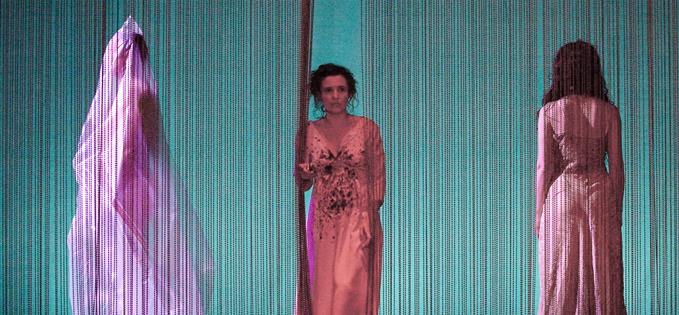∗∗∗∗∗
HOME has had a mixed season since opening on First Street. There have been some brilliant pieces of theatre but the best ones (Golem and Dead Dog in a Suitcase) were co-productions. Their in-house, much-trumpeted opener The Funfair left me cold. The Oresteia should fare better as it is directed by Blanche McIntyre, who has done some sterling work at the Royal Exchange.
A production that...delivers moments of greatness but not enough of them
McIntyre has promised audiences 'a radical, swift-moving, stripped back version'. On many levels this works, as the piece has been translated by Ted Hughes, making the beauty of the language at times beguiling. When the play begins with Hedydd Dylan sat on a swing, rising above us - bringing Hughes’ eloquent and evocative words to life with genuine skill - you sense immediately that this is going to be a fascinating production.
Sadly, this euphoric feeling dissipates as the play progresses. McIntyre decides to use a male and female chorus. The men stand on the side lines, joining in with the leader (Daniel Millar) and the females are onstage, led by Ronke Adekoluejo.
I have seen this work performed effortlessly in Medea at the National Theatre, but here it feels clunky after the first few instances. This is mainly because, however admirable it is casting locals, the results are mixed. Some of them throw themselves into it with vigour whilst others look as though they are waiting for a bus. Also, this device is so overused that you dread hearing a line which you know will be repeated, as it slows the piece down. A screen is also used to display some of the language, which again grinds it to a halt.
Lyndsey Marshall’s Clytemnestra is commanding and this actress has great stage presence, even when acting alone. She conveys, fear, strength, sarcasm and hatred and she never falters. However, the blood-soaked narrative does not really materialise visually to match her. During one supposedly horrific scene, she stands in a blood stained dress which resembles an item of clothing in a Persil advert; a before shot to prove what the product can do.
The Oresteia should be a visceral piece in order to truly work and get under your skin. Laura Hopkins’ stark set design is earthy and bare; on one hand this leaves the trained actors exposed and they rise to the challenge yet, on the other, some community chorus members appear like deer in the headlights.

However, it’s the production that lets them down. There’s also too much unintentional comedy due to (similarly to The Old Vic’s Elektra) a tendency to convey madness as moving around aimlessly, scratching in need of some Headrin. This leads to sniggers rather than the desired effect.
Lee Curran’s lighting is stunning though and it illuminates scenes with a ferocious and unforgiving glare. Dylan is mesmerising in her many guises and works wonders in a production which is fighting against her. Simon Trinder brings some welcome comic relief as Orestes but there is not much difference in tone when he plays Aegisthus.
With a real Greek tragedy playing out on our TV screens and the people of Athens genuinely frustrated and lost, there is so much that you can plunder and use for a piece such as this. But, sadly, the opportunity has been missed and you are left with a production that promises so much and delivers moments of greatness but not enough of them.
One patron on the way out of the theatre asked her friend what she thought. She said: “There was a lot of flailing and wailing and not much else”. Sadly, she was right.
The Oresteia plays at HOME until 31 October.














